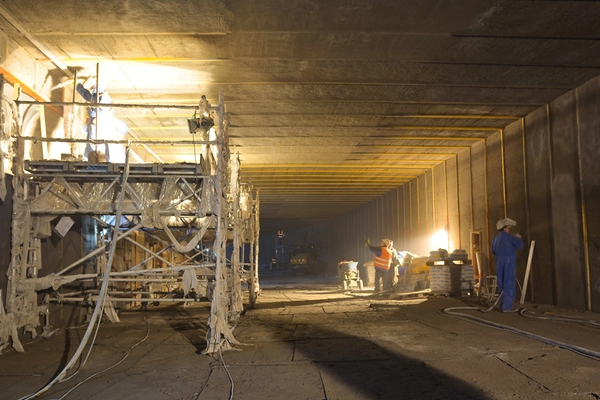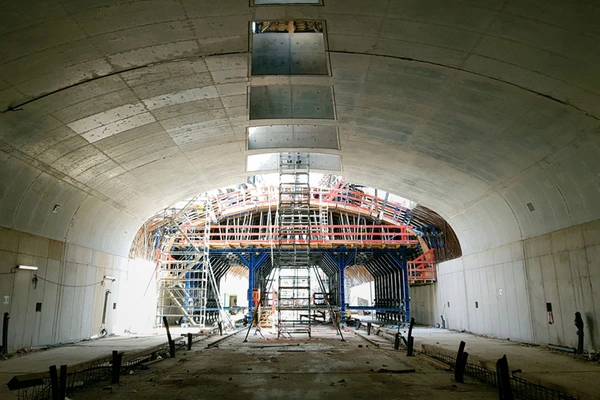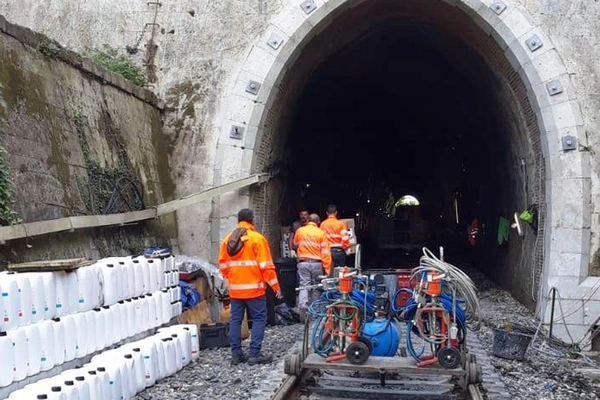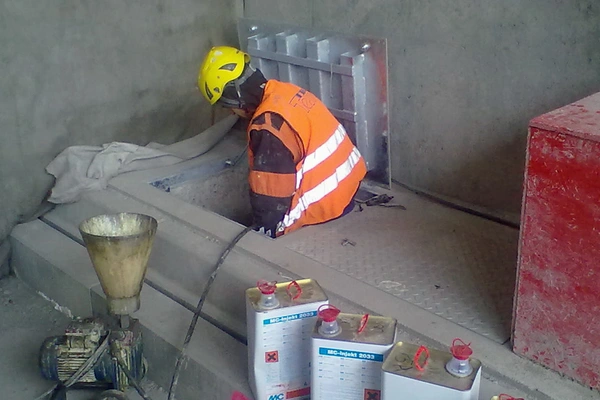Stuttgart - Germany
Name
MC´s Know-how for Stuttgart 21 - the Filder Tunnel
Country
Stuttgart - Germany
Fields of Expertise
Categories
Products
The Stuttgart-Ulm project, also known as Stuttgart 21 (S21 for short), is one of the largest infrastructure undertakings in the recent history of the Federal Republic of Germany. In future, it will add the metropolitan region in Swabia to the high-speed “Magistrale for Europe” rail link, while also serving as an important hub within the North-South and East-West Trans-European Transport Networks (TEN-T) criss-crossing Central Europe. The breakthroughs of the Filder Tunnel in September and of the Albvorland Tunnel at the end of October 2019 marked the successful conclusion of an important phase in this major project, not just for Deutsche Bahn, but also for MC and its tunnel specialists.
When Deutsche Bahn AG celebrated the symbolic breakthroughs of the Filder Tunnel on 9 September – with many of those involved in the five-year construction period as well as political representatives from the state administration, the federal government and the EU in attendance – the team of tunnel specialists from MC also had every reason to cheer. After all, MC was able to contribute a wealth of know-how of its Tunnelling Field of Expertise and thus make a notable contribution to the success of this mammoth undertaking.
With a spend of around 8 billion euros, the transformational Stuttgart 21 transport and urban development project will greatly benefit the local region through the creation in the near future of a major hub in the national – and international – railway network. More than 100 km of new, fast railway track, three new stations and an intelligent traffic management concept will set new standards in domestic German and European rail transport going forward. And there will also be major benefits on the urban planning side: About one square kilometre of current or former track sections on the edge of Stuttgart's city centre are to be put to good use in the project, extending the downtown area by around 40 percent. The client and developer overseeing this project is Deutsche Bahn. The Federal Republic of Germany, the State of Baden-Württemberg, Stuttgart’s integrated public transport authority VRS, the state capital Stuttgart, the airport company Flughafen Stuttgart GmbH and the European Union are also participating in the financing of the project. Seen in its entirety, S21 is made up of the following subprojects: The lowering of Stuttgart main station, construction of the Stuttgart railway ring track and construction of a new Stuttgart-Ulm line, which includes several tunnels. MC was significantly involved in the latter two measures in particular.
The heading operation with lining segment installation was conducted using a full-thickness-cutting shield TBM featuring multi-mode earth pressure balance (EPB) for face support. The Filder Tunnel was only one of several major tunnel projects involving MC that were mechanically excavated – the Albvorland Tunnel and the Bossler Tunnel passing through the Albaufstieg (Swabia’s Jura uplands) were also on the list. Various MC technologies and product systems were used in all the tunnel construction projects, including special products for soil conditioning, superplasticisers for lining segment production, injection systems for waterproofing the tunnels and, last but not least, a completely new, cement-free annular gap backfill grout – an innovation successfully developed in harness with the special-purpose consortium ARGE ATCOST 21.
Due to the geological conditions, the machine-excavated Filder Tunnel is divided into an upper and a lower section with two tunnel tubes each with a diameter of 10.87 m passing through an overburden of 20 to 220 m. With a total length of 9,468 m, it is the longest tunnel of the S21 project and, after completion, will be the longest double-tube railway tunnel and the third longest tunnel in Germany.
An unleached gipskeuper, consisting essentially of swellable anhydrite, is located in the rock strata surrounding the lower Filder Tunnel. Rock containing anhydrite can be found in several regions of the world, and one such is the steep slope of the Filder plateau to the south of Stuttgart. If rock containing anhydrite comes into contact with water, the volume increases by more than 60 %. This results in enormous swelling pressures which could lift the tunnel and the surrounding terrain and subsequently lead to damage to buildings and structures located above it. For the lower Filder Tunnel, the TBM was operated with an open shield, the main contact with the delicate gipskeuper strata thus being with the shield shell, the cutting tools and the annular gap backfill grout. The use of water in the more sensitive contact zones was expressly prohibited. In the case of the shield shell and the cutting tools, this was not a problem, but Deutsche Bahn demanded a specific solution for the grout that would reliably obviate the risk of swelling and ground lift.

Internal view of the tunnel boring machine in the Filder Tunnel.
© Arnim Kilgus 2023
The consortium ATCOST 21 responsible for constructing the tunnel therefore turned to MC, an approach that led to the joint development of a bespoke geopolymer. Geopolymers are inorganic binders that do not contain cement and whose structure can be traced back to the reaction of aluminosilicates in alkaline media, resulting in the formation of inorganic polymers. The special feature of the solution developed involves combining the advantages of a singlecomponent (1C) grout with those of a two-component (2C) grout through the flexible use of an activator. The basis takes the form of a modified 2C backfill grout containing a nonreactive starting aggregate predominantly present in a grain structure. Blast furnace slag and fly ash serve as the binding agents to which an activator has to be added to initiate the solidification reaction. The grout also contains complex phosphates which influence the solution equilibrium of the anhydrite in such a way that swelling is inhibited. This phenomenon can be described by the law of mass action and has been proven in trials and suitability tests. MC and PORR Bau GmbH have since patented this globally unique technology. This annular gap backfill system solution has been given the name MC-Montan Grout AA 03; it exhibits optimum bedding properties with high sulphate resistance to provide the tunnel tube with true durability.
In view of the high requirements and the omnipresent media attention surrounding S21, renowned testing institutes were consulted together with ATCOST 21 in order to scientifically investigate the feasibility of the proposed solution. The Institute for Building Research at RWTH Aachen University (ibac) was commissioned with the mineralogical petrographic investigations to determine whether possible reactions with the anhydrite could occur in the annular gap. The engineering office Brameshuber & Uebachs Ingenieure GmbH subsequently prepared the environmental analysis report. Together with the Faculty of Building Materials Technology at the Ruhr University Bochum, the material-specific technological aspects of the grout were investigated in order to ensure its application suitability measured against state-of-the-art criteria. The special sensitivity of the issue is demonstrated by the fact that the tests took more than two years in total and were only successfully completed after large-scale trials under practical conditions on the actual construction site. Subsequently, the system solution was duly approved for use for S21 projects by Deutsche Bahn and the consultant engineers. The tunnel-builders very quickly recognised the enormous advantages accruing from this modified 2C mortar compound once they began to apply it in the grouting operations for which it was designed. Despite the grain structure of the starter aggregate, activator addition was made possible before pilaster strip entry through the provision of an additional mixing section, thus ensuring effective backfilling of the annular gap as specified. The use of a non-reactive starter aggregate has the advantage that the application open time is exceptionally long, thus ensuring maximum operational flexibility in such an environment. The new cementless annular gap grout proved so successful in the S21 megaproject that it has been in great demand worldwide ever since.
Along the route of the upper Filder Tunnel, the tunnel boring machine mainly encountered Stuben sandstone, which has a high proportion of sticky clay and high-strength sandstone, with the concomitant danger of rapid tool wear. A closed shield machine was deployed on this tunnel section, with the excavated soil being used to support the working face as the TBM advanced. As mentioned above, the tunnel boring method is based on EPB technology, which is applied especially in difficult geological formations and in inner-city areas. The MC-Montan Drive product series from MC was used as the soil conditioning agent for all the mechanically excavated tunnels of the new Stuttgart-Ulm line. And the MC-Montan Device CT (Cell Tube) foam generator was employed for the efficient production of a high-quality and durable foam, enabling operations to continue with minimal interruption, minimal maintenance and minimal specific consumption values.
The most widely used soil conditioning agent was MC-Montan Drive FL 04 (Foam Liquid), an environmentally compatible and readily biodegradable foam concentrate with a defined proportion of clay additive. The product is ideally suited for soil conditioning in EPB tunnelling as well as in rock formations with a high clay content and a high likelihood of clogging. Economical in use, MC-Montan Drive FL 04 prevents deposition and agglomeration and increases the lubrication effect by dispersing the clay minerals. By repelling spoil and preventing accumulation at the cutter head, the agent also reduces TBM power consumption and cutting tool wear. Thus the soil conditioning solutions from MC were able to increase heading efficiency in all three of the tunnel projects mentioned as well as satisfy strict cost-efficiency requirements.






More References
We are continuously improving our website and we use cookies for this purpose. For an optimal user experience, we recommend that you accept them. Otherwise, parts of the page will be deactivated in the display in accordance with data protection regulations.